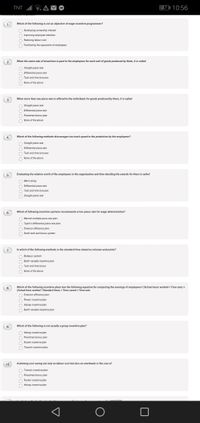
Understanding Business
12th Edition
ISBN: 9781259929434
Author: William Nickels
Publisher: McGraw-Hill Education
expand_more
expand_more
format_list_bulleted
Question

Transcribed Image Text:TNT GA
37 || 10:56
1.
Which of the following is not an objective of wage incentive programmes?
O
Developing ownership interest
Improving employee retention
O Reducing labour coat
O Facilitating the separation of employees
2.
When the same rate of incentives is paid to the omployees for each unit of goods produced by them, it is called
O Straight piece rate
O Differential piece rate
n Tesk and time bonuses
O None of the above
3.
When more than one piece rate is offered to the individuals for goods produced by them, it is called
O Straight piece rate
O Differential piece rate
O
Priestman bonus plan
O None of the above
4.
Which of the following methods discourages too much speed in the production by the employees?
O Sraight piece rate
O Differential piece rate
O Tesk and time bonuses
O None of the above
5.
Evaluating the refative worth of the employees in the organization and then deciding the awards for them is called
O Merit rating
O
Differential piece rate
O Task and time bonuses
O Svaight piece rate
6.
Which of following incentive systems recommeands a two-piece rate for wage determination?
O
Merniok muitiple piece rate plan
O Taylor's differential piece rate plan
O Emerson efficiency plan
O Gnatt tack and bonus eyetem
7.)
In which of the following methods is the standard time stated as minutes and points?
O Bedeaur system
O Barth variable incentive plan
O Task and time bonus
O None of the above
Which of the following incentive plans has the following oquation for computing the eamings of omployees? (Actual hours worked x Time rate) +
(Actual time worked/ Standard time) x Time saved x Time rate
8.
O Emerson efficiency plan
Rowan incentive plan
O Halsey incentive plan
O Barth variable incentive plan
9.
Which of the following is not usually a group incentive plan?
Halsey incentive plan
O Prieatman bonus plan
O
Rucker incentive plan
Towne's incentive plan
| 10.
Achieving cost saving not only on labour cost but also on overheads is the crux of
O
Towne's incentive plan
O Priestman bonus plan
O Rucker incentive plan
O Halsey incentive plan
Expert Solution
This question has been solved!
Explore an expertly crafted, step-by-step solution for a thorough understanding of key concepts.
This is a popular solution
Trending nowThis is a popular solution!
Step by stepSolved in 3 steps

Knowledge Booster
Similar questions
- Plz answer in brief.. How do organizations incorporate job rotation into performance management and career development discussions with employees?arrow_forwardWhat are some of the reasons why globalization and free trade are being critized? do you think that free trade is helping all countries? why or why notarrow_forwardPfizer puts forth a mission of "working together for a healthier world". Explain Pfizer strategies with the worker to increase happiness, and use an evidence to support the answer.arrow_forward
- 2. Fulfillment rates increase productivity and company revenues. How is it affecting the employee negatively AND positively?arrow_forwardHow are "Person-focused pay plans"different from "Individual incentive pay program"? "Person-focused pay plans are least preferable compared with individual incentive pay programs". Indicate whether you agree or disagree with this statement.arrow_forwardExplain tto what extent does the customization of employee rewards contribute to individualized motivation and satisfaction in the workplace?arrow_forward
- explain, h ow can organizations promote positive and productive employee behavior?arrow_forwardWould Nucor’s employee profit-sharing system work at much larger company? At what point does a company become too large for profit sharing to making a difference in employee motivation?arrow_forwardDescribe each of the 5 “S” and explain how to do it.arrow_forward
- n. X xplain the process involves in executing a motivation program in the organisational context .arrow_forward... State in n what ways can employee rewards programs be leveraged to enhance employee well-being, mental health, and work-life balance in today's dynamic work environments?arrow_forwardHow does the 7 P's affect consumer behavior thesis statementarrow_forward
arrow_back_ios
SEE MORE QUESTIONS
arrow_forward_ios
Recommended textbooks for you
 Understanding BusinessManagementISBN:9781259929434Author:William NickelsPublisher:McGraw-Hill Education
Understanding BusinessManagementISBN:9781259929434Author:William NickelsPublisher:McGraw-Hill Education Management (14th Edition)ManagementISBN:9780134527604Author:Stephen P. Robbins, Mary A. CoulterPublisher:PEARSON
Management (14th Edition)ManagementISBN:9780134527604Author:Stephen P. Robbins, Mary A. CoulterPublisher:PEARSON Spreadsheet Modeling & Decision Analysis: A Pract...ManagementISBN:9781305947412Author:Cliff RagsdalePublisher:Cengage Learning
Spreadsheet Modeling & Decision Analysis: A Pract...ManagementISBN:9781305947412Author:Cliff RagsdalePublisher:Cengage Learning Management Information Systems: Managing The Digi...ManagementISBN:9780135191798Author:Kenneth C. Laudon, Jane P. LaudonPublisher:PEARSON
Management Information Systems: Managing The Digi...ManagementISBN:9780135191798Author:Kenneth C. Laudon, Jane P. LaudonPublisher:PEARSON Business Essentials (12th Edition) (What's New in...ManagementISBN:9780134728391Author:Ronald J. Ebert, Ricky W. GriffinPublisher:PEARSON
Business Essentials (12th Edition) (What's New in...ManagementISBN:9780134728391Author:Ronald J. Ebert, Ricky W. GriffinPublisher:PEARSON Fundamentals of Management (10th Edition)ManagementISBN:9780134237473Author:Stephen P. Robbins, Mary A. Coulter, David A. De CenzoPublisher:PEARSON
Fundamentals of Management (10th Edition)ManagementISBN:9780134237473Author:Stephen P. Robbins, Mary A. Coulter, David A. De CenzoPublisher:PEARSON

Understanding Business
Management
ISBN:9781259929434
Author:William Nickels
Publisher:McGraw-Hill Education

Management (14th Edition)
Management
ISBN:9780134527604
Author:Stephen P. Robbins, Mary A. Coulter
Publisher:PEARSON

Spreadsheet Modeling & Decision Analysis: A Pract...
Management
ISBN:9781305947412
Author:Cliff Ragsdale
Publisher:Cengage Learning

Management Information Systems: Managing The Digi...
Management
ISBN:9780135191798
Author:Kenneth C. Laudon, Jane P. Laudon
Publisher:PEARSON

Business Essentials (12th Edition) (What's New in...
Management
ISBN:9780134728391
Author:Ronald J. Ebert, Ricky W. Griffin
Publisher:PEARSON

Fundamentals of Management (10th Edition)
Management
ISBN:9780134237473
Author:Stephen P. Robbins, Mary A. Coulter, David A. De Cenzo
Publisher:PEARSON